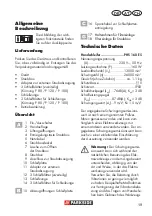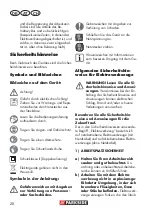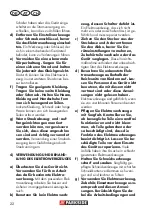
G B
IE
7
NI
matching outlets will reduce risk of elec-
tric shock.
• Avoid body contact with earthed
or grounded surfaces, such as
pipes, radiators, ranges and re-
frigerators.
of electric shock if your body is earthed
or grounded.
• Do not expose power tools to
rain or wet conditions.
Water
entering a power tool will increase the
risk of electric shock.
• Do not abuse the cord. Never
use the cord for carrying, pull-
ing or unplugging the power
tool. Keep cord away from
heat, oil, sharp edges or moving
parts.
Damaged or entangled cords
increase the risk of electric shock.
• When operating a power tool
outdoors, use an extension cord
suitable for outdoor use.
Use of a
cord suitable for outdoor use reduces
the risk of electric shock.
• If operating a power tool in a
damp location is unavoidable,
use a residual current device
(RCD) protected supply.
Use of an
RCD reduces the risk of electric shock.
3) PERSONAL SAFETY
• Stay alert, watch what you are
doing and use common sense
when operating a power tool.
Do not use a power tool while
you are tired or under the influ
-
ence of drugs, alcohol or medi-
cation.
A moment of inattention white
operating power tools may result in
serious personal injury.
• Use personal protective equip-
ment. Always wear eye protec-
tion.
Protective equipment such as dust
mask, non-skid safety shoes, hard hat,
or hearing protection used for appro-
priate conditions will reduce personal
injuries.
• Prevent unintentional starting.
Ensure the switch is in the off-po-
sition before connecting to power
source and/or battery pack,
picking up or carrying the tool.
the switch or energising power tools that
have the switch on invites accidents.
• Remove any adjusting key or
wrench before turning the pow-
er tool on.
A wrench or a key left
attached to a rotating part of the power
tool may result in personal injury.
•
Do not overreach. Keep proper
footing and balance at all times.
tool in unexpected situations.
•
Dress properly. Do not wear
loose clothing or jewellery.
your hair, clothing and gloves away
from moving parts. Loose clothes, jew-
ellery or long hair can be caught in
moving parts.
•
If devices are provided for the
connection of dust extraction
and collection facilities, ensure
these are connected and prop-
erly used.
Use of dust collection can
reduce dust-related hazards.
4) POWER TOOL USE AND CARE
•
Do not force the power tool. Use
the correct power tool for your
application.
will do the job better and safer at the
rate for which it was designed.
•
Do not use the power tool if the
switch does not turn it on and
off.
Any power tool that cannot be








































